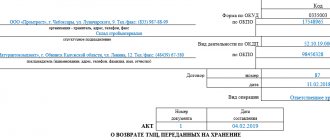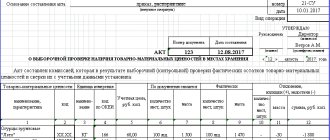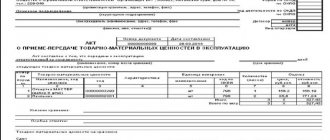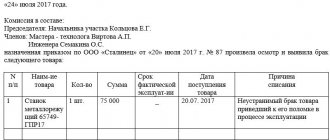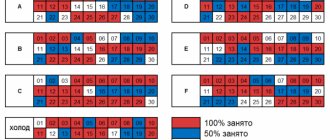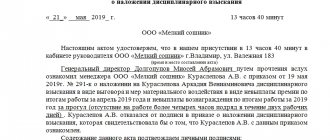Form M-35. Act on the posting of material assets
The act of recording material assets in form M-35 is used to document inventory and materials received during the demolition and dismantling of buildings and structures.
Through it, they can be classified as the organization’s fixed assets and used in its economic activities. FILES
The document must be drawn up by a specially created commission. Moreover, there must be at least three people in total. Naturally, it should include both representatives of the customer and representatives of the contractor. The presence of signatures of representatives is in the interests of each organization. Without them, the act will not have legal force.
How to correctly draw up a computer assembly certificate
When drawing up a computer assembly certificate or an accounting certificate, a unified sample or one compiled independently is used. In the latter case, the template is approved by the head of the enterprise, and this form is used in the future.
To receive a PC assembly certificate or OKUD form 0504833, the accounting department carries out the following manipulations with materials:
In this order, the accounting certificate OKUD 0504833 is generated. When the certificate is created independently and approved by management, the main element of the form is the required details. Since the accounting certificate is the primary documentation, the form must contain mandatory details in accordance with Art. 9 Federal Law No. 402 dated December 6, 2011 (as amended on July 29, 2018):
- date of creation of the template;
- name of the document, enterprise, structural unit;
- document-basis for registration of the form;
- space for the signature of the responsible person, including the chief accountant.
To record the write-off of materials for computer assembly, add a table to the form with a list of elements and their cost. At the end or beginning of the documentation, the names and numbers of the operations indicated above must be indicated. Naturally, you need a table with a list and cost of each material used, for example: “mouse”, “keyboard”, “system unit”, etc.
Is this form required?
Since 2013, all unified forms have lost paramount importance. They remained mandatory for use only in exceptional cases provided for by law. But the M-35 form does not apply to these exceptions. An act on the recording of material assets after the demolition of a building can be drawn up in any form convenient for the organization.
The only fundamental point remains the nuance that any form created personally must be entered into the company’s accounting policy by a separate order from the manager. Therefore, if such a process occurs for the first time in a company, it is necessary to ensure that by the time of signing the act is already listed in the accounting policies as a developed document.
Moreover, you can use both a unified and your own form of the form. The slightest changes and additions to the unified form make it independently developed.
Installation of spare parts
If there is a need for repairs and installation of spare parts, the organization can perform the required work on its own, if there are appropriate specialists on staff, or with the involvement of outside workers and concluding an agreement with them to provide the necessary services. In this case, the document will be considered the basis for further write-off of spare parts that were used, and will also serve as confirmation of the subsequent completion of work on the installation of parts.
An organization does not always have parts for repairs; then, before carrying out work, you must first purchase spare parts and register them as material assets belonging to the company, and only after that carry out replacement with the execution of the necessary installation certificate.
Private companies have no restrictions on the use of forms. Details can be entered into the list on the basis of invoices or receipt orders received, and the organization, if there is such a need, can develop some original forms for this purpose. The use of unified forms is not required by law, but any form must contain the company’s current details. After purchase, spare parts are processed in the warehouse and entered into the documents used for accounting, or, if necessary, sent directly to the company department that needs these parts.
For those organizations that are institutions, there are guidelines and forms for such a case. For received spare parts and their registration, a corresponding receipt order and a special approved form are used. Accounting is carried out in the appropriate book or cards of material assets, and issuance to departments is made when the corresponding invoice is issued, with the completion of the statement.
After installing the spare parts, the commission makes an appropriate decision to write off the used valuables, and also draws up a special act confirming this. The document is signed by the manager and sent to the accounting department. Institutions use an approved form for write-offs.
Sample of filling out form M-35
The document consists of several separate elements:
- Hats.
- Two tables in the main part.
- Conclusions in the form of a conclusion to the second table and signatures of the members of the convened commission.
At the top there is a little space left for the visa of the head of the organization, who certifies the paper. After filling out the document, his signature with a transcript and position should appear in the required columns. If the organization has a seal, then its imprint is placed here.
Number of copies
The installation act is a “safety cushion” for organizations that install and install various types of equipment, structures, etc. Therefore, the act is usually drawn up in at least two copies. One is needed for the customer, the other for the installation contractor.
If the customer goes to court, the contractor can always prove through an act that the work was at least carried out.
Even if an organization installed material assets on its own, this document must appear in the financial statements to calculate remuneration for the employee who carried out the installation. It is also needed to write off acquired material requirements, followed by adding their value to the total value of equipment or other property of the organization.
Introductory part of the act
After the name of the document and its number in the middle of the sheet there are sequential columns in which, when filling out, indicate:
- Name of the compiler's organization.
- Name of the customer organization.
- Contractor company name.
- Name of the appraisal organization or several. Only those who were directly involved in the process of assessing material assets obtained during disassembly are indicated.
Separately on the right in the attached form of the act there is a small table. It already contains the OKUD form number. If at least one column in the act is changed, then this number will need to be removed. This requirement is related to the rules for the use of unified forms of documentation.
In addition to the OKUD code, the attached act has columns for indicating OKPO. In the smaller of the three tables, it is also necessary to fill in the columns: “Date of compilation”, “Operation type code”, “Name of the structural unit” and “Type of activity”. Not all of them are required to be filled out. For example, if there are no structural divisions in the organization, then the entire corresponding column can be left blank. This is not forbidden.
Write-off of fixed assets: dismantling
In order to correctly draw up supporting documentation that complies with OKUD 0504833, you should focus on a sample computer assembly certificate. The recommendation uses a template for a unified form of accounting certificate.
After a group of specialists decides to begin partial liquidation, the head of the company must issue another order, which will determine the accounting procedure for this process. In the meantime, the commission draws up an act for writing off the original fixed asset as a result of its partial liquidation.
The document must indicate: — the date the object was accepted for accounting; — year of manufacture or construction; — commissioning time; — useful life; — initial cost and amount of accrued depreciation; — possible revaluations, repairs, reasons for disposal; — condition of parts, assemblies, structural elements.
(19,833.33 - 944.44). In accordance with Government Decree No. 1 of 01.01.2002 “On the Classification of fixed assets included in depreciation groups,” electronic computing equipment (computer) refers to machinery and equipment and is included in the second depreciation group with a useful life of more than two years to three years . Thus, the computer should be accounted for in account 4 101 34 310 “Machinery and equipment - other movable property of the institution.”
Let's consider the most common case in organizations - the acceptance for accounting of items assembled from components. 1. How is the assembly of a computer documented if it is assembled from individual components that the enterprise bought separately League 2010-04-11 In this case, you should be guided by: - general requirements for documenting the independent production (construction) of fixed assets, if the computer is assembled for “fundamental” goals;
– general “production” requirements for the manufacture of products intended for sale. 1. If we are talking about a computer - an object of fixed assets. A guide for beginners: Assembling a computer with your own hands in detail In order to assemble it all into a single whole, we need only one tool - a medium-sized Phillips screwdriver, preferably with a magnetic tip. And of course a pair of straight hands.
When posted, the document generates the following postings: For Ukraine - corporate configuration Debit Credit Description Balance sheet (entries in the accounting registers) 0.372.030 Inventory account Cost of written off inventory items Inventory account 0.372.030 Cost of capitalized inventory items Off-balance sheet (entries in inventory registers) MOL 0 Write-off of inventory items 0 MOL Capitalization of inventory items Acquisition is carried out through the materially responsible person.
Correcting the initial cost of an object involves changing the information recorded in the inventory card. Finally, you need to reduce the initial cost of the OS by the cost of the seized object.
Let's look at the wiring that is used during disassembly:
- DT01.09 CT01.01. Write-off of a commission share of the initial cost of fixed assets based on partial liquidation.
AttentionPrimary documentation: commission act, dismantling order, OS tool inventory card.
- DT02 KT01.09. Write-off of part of the depreciation that was accrued before dismantling work.
Information about the condition of the equipment as of the date of disassembly: Name of equipment Number Date Actual service life Initial cost at the time of acceptance to accounting Amount of accrued depreciation (wear and tear), rub. Remaining exact cost, rub. Inventory factory release (post-construction) acceptance for accounting or replacement cost, rub.
- Order a demo Free, in your office
- Buy a document For only 49 rubles.
The payment process is completing.
For Ukraine - standard configuration Debit Credit Description Balance sheet (in the accounting registers) 3723 Inventory account Cost of written-off inventory items Inventory account 3723 Cost of capitalized inventory items Off-balance sheet (entries in warehouse accounting registers) MOL 0 Write-off of inventory items 0 MOL Capitalization of inventory items Acquisition is carried out through the materially responsible person .
Main part
For convenience, the description of material assets obtained during the dismantling of buildings and structures is presented in the form of a lengthy table with separately labeled columns. They should include information regarding:
- Corresponding account. This column is divided into two: the first part indicates the subaccount, and the second - the analytical accounting code. This data is filled in by the accountant.
- The nature of the remaining material assets. Their name, variety or brand are indicated, as well as, if the organization has adopted such a system, the nomenclature number.
- Units of measurement of goods and materials, its code.
- The quantities of the specified material resource.
- The suitability coefficient of the material obtained during disassembly.
- How much of the material received was transferred to another company for reuse.
- Prices and total amount of materials that are transferred to the organization.
The table is placed on two sheets. In the vast majority of cases, this space is sufficient for a detailed description of the categories of material assets obtained during analysis. And also their quantities and prices.
At the end of the table, the results are summed up, and it is also indicated that the inventory items have been accepted, are subject to capitalization, and that some of them (or all) are transferred to the contractor for reuse.
As a sign that the data indicated in the table is correct, all members of the commission put their signatures at the end of the act. If necessary, the participants in the process leave notes and draw up applications.
Moreover, the contractor’s representatives sign on the right side, and the customer’s representatives sign on the left. Both sides of the conclusion of the act on the posting of material assets in form M-35 must be completed. Without this, the document will not have legal force.
act on receipt of materials
All companies are required to document transactions involving the movement of material assets in appropriate forms.
The act on the capitalization of material assets is used to account for inventory items that were received as a result of the liquidation of fixed assets, but are suitable for further use in the operation of the enterprise.
In such cases, the established form M-35 is used. The company's loss is reduced by the cost of material assets that were obtained as a result of dismantling and dismantling structures and buildings.
The act is drawn up by a commission, the composition of which is formed taking into account representatives of the customer and the contractor, in triplicate. The form can be filled out manually or using computer technology.
The act indicates such data as the number, names of the customer and contractor organizations, as well as the name of the involved appraisal companies. The date of preparation of the document, the code of the type of operation, the name of the unit and its type of activity are indicated.
A special column records information about the material value and its characteristics (name, size, code, grade), item number, unit of measurement and quantity obtained during dismantling of structures or buildings. The utility coefficient of inventory items from the total quantity is indicated.
In the designated column, the quantity and price per unit of material assets is written down and the total amount of materials that are transferred to the contractor for reuse is entered.
At the end of the act, all members of the commission sign with a description of the position. The act is certified by the seals of the companies. Two copies of the act remain with the customer company, the third is transferred to the contractor. The customer attaches the document to the contractor's invoice.
Form form No. M-35. Act on the recording of material assets received during the dismantling and dismantling of buildings and structures
The form of the Act on the capitalization of material assets received during the dismantling and dismantling of buildings and structures in form No. M-35 is used to register the capitalization of material assets received during the dismantling and dismantling of buildings and structures suitable for use in the production of work.
The act is drawn up in triplicate by a commission consisting of representatives of the customer and contractor, and signed by representatives of the customer and contractor.
The first and second copies of the act remain with the customer, the third - with the contractor. The customer, in turn, attaches the first copy of the act to the submitted invoice for payment to the contractor.
Form M-35. Act on the posting of material assets
The act of recording material assets in form M-35 is used to document inventory and materials received during the demolition and dismantling of buildings and structures. Through it, they can be classified as the organization’s fixed assets and used in its economic activities.
The document must be drawn up by a specially created commission. Moreover, there must be at least three people in total. Naturally, it should include both representatives of the customer and representatives of the contractor. The presence of signatures of representatives is in the interests of each organization. Without them, the act will not have legal force.
How many copies will be required?
Form M-35 is issued in triplicate. The first one remains with the contractor. The remaining two go to the customer. The customer attaches one of the original documents to the invoice.
In principle, the number of copies of the act created is not limited in any way. If three or more parties take part in the process, then it would be more logical to sign the document in four copies at once, etc.
Is this form required?
Since 2013, all unified forms have lost paramount importance. They remained mandatory for use only in exceptional cases provided for by law. But the M-35 form does not apply to these exceptions. An act on the recording of material assets after the demolition of a building can be drawn up in any form convenient for the organization.
The only fundamental point remains the nuance that any form created personally must be entered into the company’s accounting policy by a separate order from the manager. Therefore, if such a process occurs for the first time in a company, it is necessary to ensure that by the time of signing the act is already listed in the accounting policies as a developed document.
Moreover, you can use both a unified and your own form of the form. The slightest changes and additions to the unified form make it independently developed.
In the attached form and sample act in the upper right corner there is information that the form was adopted by Resolution of the State Statistics Committee No. 71 A of October 30, 1997.
At that time it was mandatory for use in all companies.
As you can see, it has not lost its popularity to this day due to its ease of use and the conservatism of the Russian document management system and regulatory authorities.
The document consists of several separate elements:
- Hats.
- Two tables in the main part.
- Conclusions in the form of a conclusion to the second table and signatures of the members of the convened commission.
At the top there is a little space left for the visa of the head of the organization, who certifies the paper. After filling out the document, his signature with a transcript and position should appear in the required columns. If the organization has a seal, then its imprint is placed here.
After the name of the document and its number in the middle of the sheet there are sequential columns in which, when filling out, indicate:
- Name of the compiler's organization.
- Name of the customer organization.
- Contractor company name.
- Name of the appraisal organization or several. Only those who were directly involved in the process of assessing material assets obtained during disassembly are indicated.
Separately on the right in the attached form of the act there is a small table. It already contains the OKUD form number. If at least one column in the act is changed, then this number will need to be removed. This requirement is related to the rules for the use of unified forms of documentation.
In addition to the OKUD code, the attached act has columns for indicating OKPO.
In the smaller of the three tables, it is also necessary to fill in the columns: “Date of compilation”, “Operation type code”, “Name of the structural unit” and “Type of activity”. Not all of them are required to be filled out.
For example, if there are no structural divisions in the organization, then the entire corresponding column can be left blank. This is not forbidden.
For convenience, the description of material assets obtained during the dismantling of buildings and structures is presented in the form of a lengthy table with separately labeled columns. They should include information regarding:
- Corresponding account. This column is divided into two: the first part indicates the subaccount, and the second - the analytical accounting code. This data is filled in by the accountant.
- The nature of the remaining material assets. Their name, variety or brand are indicated, as well as, if the organization has adopted such a system, the nomenclature number.
- Units of measurement of goods and materials, its code.
- The quantities of the specified material resource.
- The suitability coefficient of the material obtained during disassembly.
- How much of the material received was transferred to another company for reuse.
- Prices and total amount of materials that are transferred to the organization.
The table is placed on two sheets. In the vast majority of cases, this space is sufficient for a detailed description of the categories of material assets obtained during analysis. And also their quantities and prices.
At the end of the table, the results are summed up, and it is also indicated that the inventory items have been accepted, are subject to capitalization, and that some of them (or all) are transferred to the contractor for reuse.
As a sign that the data indicated in the table is correct, all members of the commission put their signatures at the end of the act. If necessary, the participants in the process leave notes and draw up applications.
https://youtu.be/-a47qmeK-uM
Moreover, the contractor’s representatives sign on the right side, and the customer’s representatives sign on the left. Both sides of the conclusion of the act on the posting of material assets in form M-35 must be completed. Without this, the document will not have legal force.
Acceptance and write-off of materials: we prepare documents
We thank Elena Sergeevna Shatalova, chief accountant of Technolux Metal LLC, Moscow, for the proposed topic.
Now it is not necessary to use unified primary forms, including those provided for accounting for materials and their movement. Therefore, organizations are slowly beginning to reshape Goskomstat forms to suit themselves. And on this wave, accountants are once again asking the question: what document will be the basis for accepting materials for accounting and writing them off as expenses?
Speaking about materials, we will consider production materials and raw materials, and office materials, for example, stationery.
Documenting the arrival of materials to the organization
The posting of materials implies not only their physical receipt by the financially responsible employee of the organization (for example, a storekeeper), but also their reflection on the accounting accounts (as a rule, this is a debit posting to account 10 “Materials”).
There are several options for documentation, and they often depend on the situation that arises when receiving materials, as well as on the structure of the organization and the internal document flow system adopted in it.
Receipt order according to form No. M-4. It is used if there are no comments on the quality and range of materials. Only the form No. M-4 is quite large. Therefore, you can easily remove from it some details that are not related to the mandatory details of the primary document and clause 2 of Art. 9 of the Law of December 6, 2011 No. 402-FZ (hereinafter referred to as the Accounting Law):
- numbers of forms according to OKUD and OKPO;
- passport number (it makes sense to leave it only if you are bringing materials containing precious stones and metals);
- information about the insurance company;
- column with the unit of measurement code.
Stamp on the invoice
Source: https://gladweb.ru/dom-i-semyya/akt-na-oprihodovanie-materialov/
The obligation to use form M-35 to draw up a capitalization act
Recently, the obligation to use many unified forms, including Act M-35, has been abolished. Therefore, today, various forms developed by employees of organizations and subsequently established by the company’s management in the accounting policies can be used as a capitalization act. However, to draw up such an act, the above form is often used, since it is quite convenient to use for the conservative document flow of Russian companies.
Important! Any changes in the unified form M-35 make the act form independently developed, which does not give the organization the right to indicate the corresponding OKUD code on it, therefore they must be approved and included in the accounting policy by order of the director.
| ★ Best-selling book “Accounting from scratch” for dummies (understand how to do accounting in 72 hours) > 8,000 books purchased |
Deed of breakdown - why is it needed and when is it drawn up?
A report of equipment failure is required for warranty replacement or repair of equipment.
If we are talking about a budgetary institution, then it may be needed to allocate funds for the purchase of new equipment.
A striking example is the installation of refrigerators in stores. They are usually allocated by suppliers for specific products. If one of the refrigerators breaks down, you need to draw up a report for subsequent repair or replacement.
| Situation | Description |
| Upon arrival at the warehouse | Typically, all equipment is delivered in packaging, so testing its performance can be problematic, especially with large deliveries. Faults may indicate a manufacturing defect or shortcomings that arose during the delivery process: for example, if the goods were handled carelessly by the loaders |
| When tested | During the commissioning process, the equipment is tested for technical faults that were not detected during the installation process or upon arrival at the warehouse for storage and further transportation. In this situation, both technical defects and non-compliance with previously stated characteristics may be identified. |
| During installation | At this time, craftsmen may discover manufacturing defects and other problems that prevent full operation |
We invite you to familiarize yourself with the Notification of the interim liquidation balance sheet, sample filling
Another example is the installation of fire alarms in educational institutions. This is done by the organization that won the bid. To fulfill the terms of the contract, it is necessary to purchase sensors, remote controls, cables and other equipment that allows timely detection of fires and sending signals.
The company that installs the alarms orders them from the supplier. If upon receipt at the warehouse or during the installation process it is determined that the equipment is faulty, a report must be drawn up. Without this, replacement cannot be made.
Rules for drawing up an act in form M-35
First of all, during the dismantling of a fixed asset, it is necessary to convene a commission, which should include representatives of all parties.
Such a commission identifies materials suitable for reuse from dismantled structures, and also identifies all information related to their accounting. The document contains information about each such material. In this case, new lines are filled in for each item.
The document consists of two sheets on which the tabular part is located. And, as a rule, this space is enough to draw up Act M-35. However, if there is so much “old new” material that there is not enough space in the document, an appendix is drawn up for the act, which is the same table, in which the same details are indicated and the same columns are filled in.
Dismantling of fixed assets (Lunina o.)
In the document Free receipt of fixed assets and intangible assets with the operation Receipt of fixed assets as a result of dismantling (101.xx - 401.10.172), objects received as a result of disassembly, costing more than 40,000 rubles, should be entered as separate inventory objects with the assignment of an individual inventory number, setting for each (Fig. 3, lines 1-2):
- Procedure for calculating depreciation - Calculation of depreciation;
- The method of calculating depreciation is Linear.
The remaining useful life should also be indicated. For objects worth up to 40,000 rubles. You can set the sign of maintaining group accounting by assigning individual inventory numbers. In this case, each inventory number is entered into the document with an indication for each (Fig.
For Russia - standard configuration Debit Credit Description Balance sheet (in the accounting registers) 71.01 Inventory account Cost of written-off inventory items Inventory account 71.01 Cost of capitalized inventory items Off-balance sheet (entries in warehouse accounting registers) MOL 0 Write-off of inventory items 0 MOL Capitalization of inventory items Acquisition is carried out through the materially responsible person .
Dmitrieva D.K. 12/13/2005 Margarita Zgirovskaya, auditor, “Chief Accountant” magazine. Pricing" No. 12, 2005. For a more detailed study, see
The procedure for drawing up an act of capitalization of goods and materials in form M-35 and its sample
When registering the operation of capitalizing materials obtained as a result of dismantling or disassembling fixed assets, using form M-35, first of all, you must fill out the details of the document header, namely:
- Name of the legal entity that prepared the document;
- Name of customer and contractor organizations;
- Data from appraisers or appraisal organizations.
Important! In the upper right corner of the act the number of the M-35 form according to OKUD is indicated. If the specified document undergoes changes in the composition of the details, then this code must be removed from there, since such a form will be considered newly created.
Here you need to fill out the tabular part, where the following data should be indicated:
- Date of document execution;
- Type of operation (Code);
- Structural subdivision;
- Kind of activity.
After filling out the above details, the drafters of the capitalization act must fill out the main tabular part. This includes information about the organization’s correspondent account in which this or that material is recorded. This field is filled in by an accountant. It should be noted that for convenience it is divided into two, and they indicate the subaccount and analytical accounting code. Then information is entered about the remaining materials that are in good condition after dismantling, allowing them to be used. For each such product, the item number, information about the unit of measurement, as well as the amount of material obtained after disassembly are indicated. A very important point is to indicate the serviceability coefficient of inventory items; it is this figure that makes it clear how worn out the material resource is and whether it can be used in the future. Among other things, the amount of suitable material transferred for reuse, the price and its full cost are indicated.
The final part of the document summarizes the results: it notes the fact that the goods were accepted into the warehouse, as well as the fact that the goods were received or sent for reuse by the contractor. Members of the commission confirm the information specified in the registration act M-35 with signatures. In this case, the contractor’s representatives sign on the right side, and the customer’s representatives sign on the left side of the document.
You can fill out the act of capitalization of goods and materials in form M-35 here - a sample design.
Installation procedure for spare parts
If there is a need to install a spare part, the organization can carry out this procedure on its own (if specialists are available) or involve a third-party specialized organization by concluding an appropriate agreement with it. The installation certificate will be the basis for writing off the corresponding material assets, and in the latter case, also confirmation of the fact that the contractor has completed the installation work.
The organization may not have a spare part. Then the latter must first purchase the part and take it into account as a material value.
A private organization is not limited to using a specific form to formalize the acquisition of material assets. Spare parts can be capitalized on the basis of documents according to the forms TORG-12 (invoices) or M-4 (receipt orders) approved by the State Statistics Committee of Russia. An organization can also develop and approve its own forms for these purposes. Since January 2013, these forms, as well as other forms included in the albums of unified forms of primary accounting documentation, are not mandatory for use. At the same time, the form approved by the organization itself must contain the details required by law (in particular, the Federal Law “On Accounting” dated December 6, 2011 N 402-FZ, Art. 9). Purchased spare parts are entered into accounting documents at the warehouse or immediately sent to the appropriate structural unit that needs them.
If the organization is an institution, it must be guided by the Methodological guidelines and forms approved by Order of the Ministry of Finance of Russia dated March 30, 2015 No. 52n. In particular, to register the receipt of spare parts, a receipt order for the acceptance of material assets (non-financial assets) in the form 0504207 (according to OKUD) is used, inventory and materials are recorded in a book or cards for recording material assets, and the issuance to the relevant structural unit is formalized by drawing up a demand invoice in the form 0504204 and statements of issuance of material assets for the needs of the institution in the form 0504210.
After installing a spare part in a private organization, the commission for writing off valuables makes a decision on writing off this material value from the register and draws up a write-off act, which is approved by the manager and sent to the accounting department to make the necessary entries. In an institution, the write-off is documented in a document in the form 0504230 - an act on the write-off of inventories.
Answers to frequently asked questions
Question N1: Good afternoon! Our organization needed to dismantle the television mast. As a result of disassembly, scrap ferrous metal was left behind. Can form M-35 be the basis for recording such material? Or do we need to register the posting in some other way?
Answer: Hello! Materials obtained as a result of dismantling fixed assets that are not real estate should be formalized with a demand invoice in form M-11. Form M-35 is used when capitalizing inventory items remaining after the dismantling of buildings and structures. In your case, it is advisable to convert the document into a demand invoice in form M-11 or use your own form developed at the enterprise.
Question N2: Good afternoon! The contractor and I had a dispute about who was required to fill out the M-35 form, due to which the materials obtained as a result of dismantling the building were not properly processed. Please allow it.
Answer: Hello! It was already said earlier that filling out the posting act is the work of a specially assembled commission, which includes both the customer’s employees and the contractor’s employees. To prepare the document, assemble a commission that will consist of at least three people and let it evaluate the received material, on the basis of which it will fill out Act M-35.
Components of the act
Like any free-form document, the paper has three main sections:
- introductory;
- basic;
- final.
The introductory part contains basic information regarding the name of the document itself (the inscription is located at the very top of the paper, in the middle), which of the agreements it relates to (with a mention of its number and dating), the place where the act was concluded (the city in which it is drawn up and signed), deadline. Most of the information is contained in the main section. It describes:
- Who is the customer? If this is an organization, then the full name of the representative of the organization and his position are indicated. The document on the basis of which an employee of the organization acts is also important.
- Who is the installer (contractor). If this is an organization, then the full name of the person responsible for the installation is also indicated with reference to the supporting documents (charter, power of attorney, etc.).
- The contract that was previously concluded - its date and number.
- What kind of equipment was installed and when?
- The amount for which the work was performed. If an organization works with VAT, then this parameter is also specified.
- How much money should be transferred to the contractor’s account for the work performed.
- How many copies of the document have been compiled?
The final section consists of the names of organizations, their details and signatures of responsible persons.
Who disassembles the OS and how?
The disassembly of the OS is carried out as follows according to a strict algorithm:
- An order is issued to dismantle the OS.
- The amount of depreciation of the fixed asset is determined.
- Disassembly costs are taken into account, which includes the creation of a commission by order of the company's general director.
The commission should include the chief accountant of the enterprise, as well as employees responsible for the safety of the organization’s facilities.
When accounting for expenses, several methods are used:
- If an item of fixed assets will continue to be used, its disposal costs are included in the cost at which it is accounted for in the warehouse.
- If the equipment is no longer used, it is disposed of, and the costs are included in other non-operating expenses.
Immediately after the dismantling work is completed, an acceptance certificate for the fixed asset, as well as modernized and reconstructed facilities, must be drawn up.
As a result, the accounting department must calculate the cost of the main property, taking into account the reduction by the cost of those components that were removed and reconstructed.
The following expenses must be reflected in accounting documents:
- Costs for dismantling capital equipment.
- VAT amount from the contractor.
- Contractor payment.
- Depreciation of a new object.
All documents must be drawn up in accordance with accounting rules and signed by the chairman of the commission and the general director of the enterprise.
Filling out a sample document form
The act of dismantling equipment does not have a clear form; it depends largely on the specifics of the enterprise, as well as on the type of fixed asset that is subject to disassembly.
But the approximate form is almost the same everywhere. It includes the following information:
- Full name of the manager who approves the act, as well as date and signature.
- Who drew up the act (the commission and all its members who must sign the act).
- Place of compilation.
- Reason (number and name of the order for dismantling the main equipment).
- Reason for dismantling.
The following is a table containing the following information in the columns:
- Name of the dismantled equipment.
- Inventory and serial numbers of dismantled items.
- Date of release or construction of the object of interest.
- Date of acceptance of the fixed asset for accounting.
- The period of actual operation of an object that occurs at a given enterprise.
- The initial cost of the object at the time of acceptance for accounting.
- The amount of accrued depreciation.
- Residual value of dismantled equipment.
Only on the basis of such an act does the enterprise have the right to sell disassembled goods. In this case, the capitalization of the former equipment occurs at the residual price, which is indicated in the act.
Download for free a sample sample of the act of dismantling fixed assets – word.




